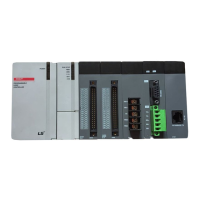Chapter 8 Motion Control Function
8.4 Coordinate Systems Operation Function
8.4.1 Summary of the Coordinate Systems Operation
Different coordinate systems define various ways specifying certain positions or directions in the space. The figure below shows how
to represent a certain TCP through each coordinate system. In the ACS coordinate system, TCP is represented as the rotation angle of
a robot joint consisting of two links. In the MCS coordinate system, TCP position is represented based on the home position of MCS. In
the PCS coordinate system, TCP position is represented based on the home position of TCP
TCP represented as PCS/MCS cannot be delivered to the motor connected to the robot for operation. To operate the motor connected
to the robot, the values converted to ACS should be used, as it represents the actual movement of the motor. Therefore, for operation
in a coordinate system, convert PCS to MCS coordinates through the Cartesian coordinate conversion, and convert the MCS
coordinates to ACS coordinates through inverse kinematics conversion, and deliver the CA values to each motor to begin operation.
8.4.2 ACS/MCS/PCS/TCP
ACS: Axes Coordinate System (ACS) represents the actual movement of the physical motors.
MCS: Machine Coordinate System (MCS) is related with machines (robots). It is the fixed home position of the mechanical
system represented as the Cartesian coordinate system.
PCS: Product Coordinate System based on MCS represents the position of products being moved or rotated. PCS is linked
to the products through a program, and a user can be changed.
TCP(Tool Center Point) is the center or end point of the tool as a position to which a machine (robot) is moved by the
command. In case of operation using MCS or PCS, the target position is represented by TCP. TCP consists of 6 RotC data:
Px,Py,Pz, representing movement along XYZ axes; RotA representing rotation along X axis; RotB representing rotation
along Y axis; and RotC representing rotation along Z axis.

